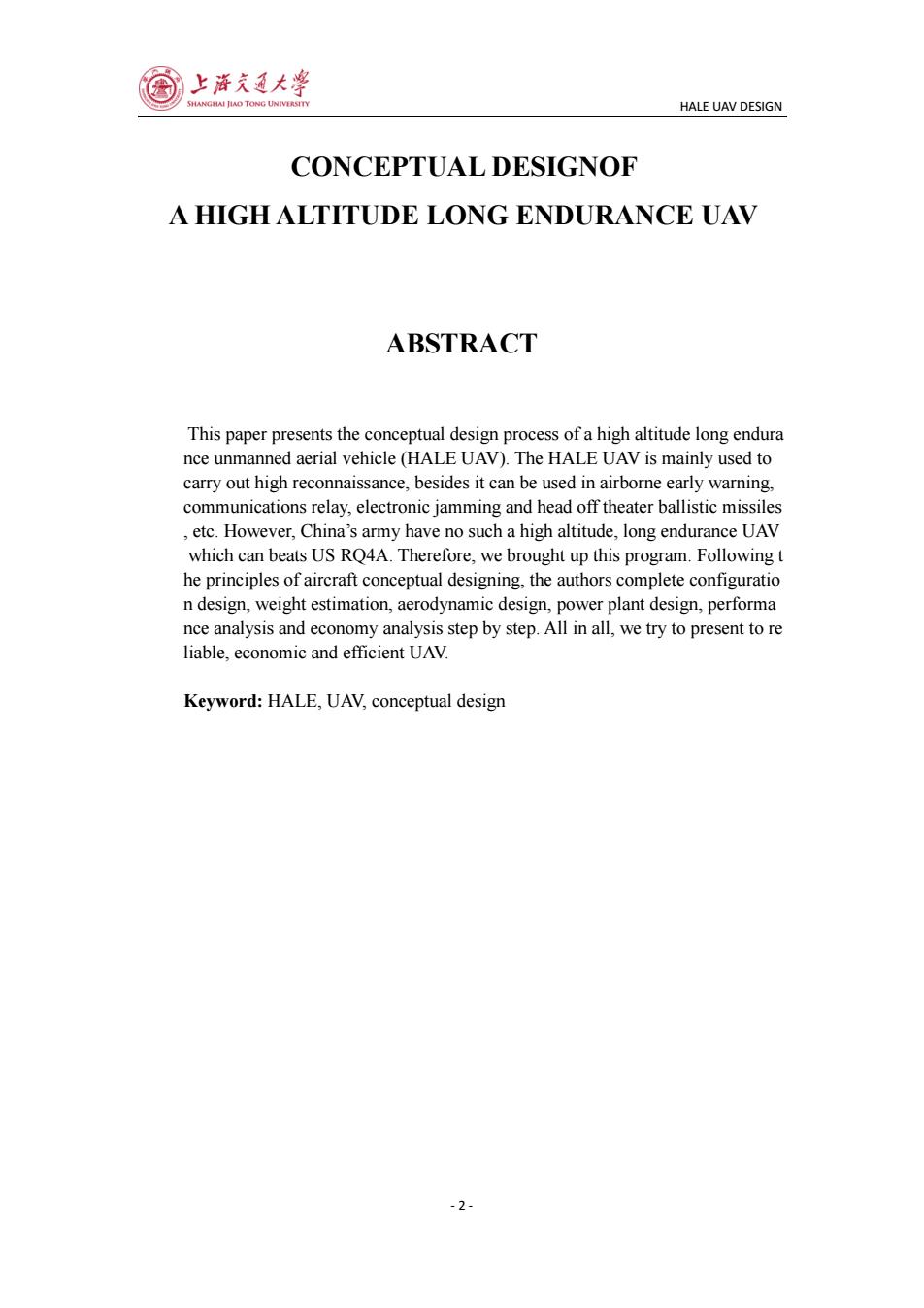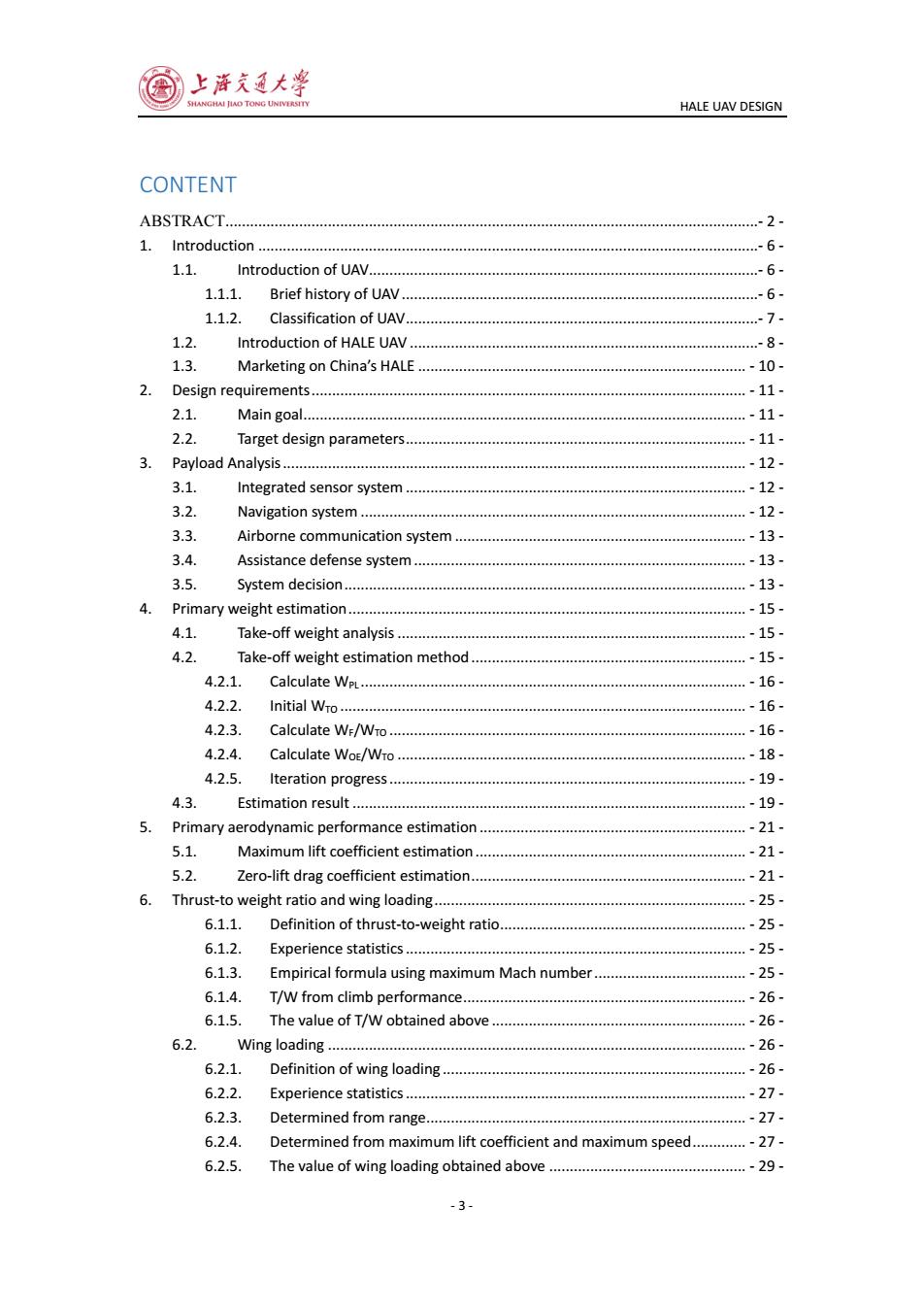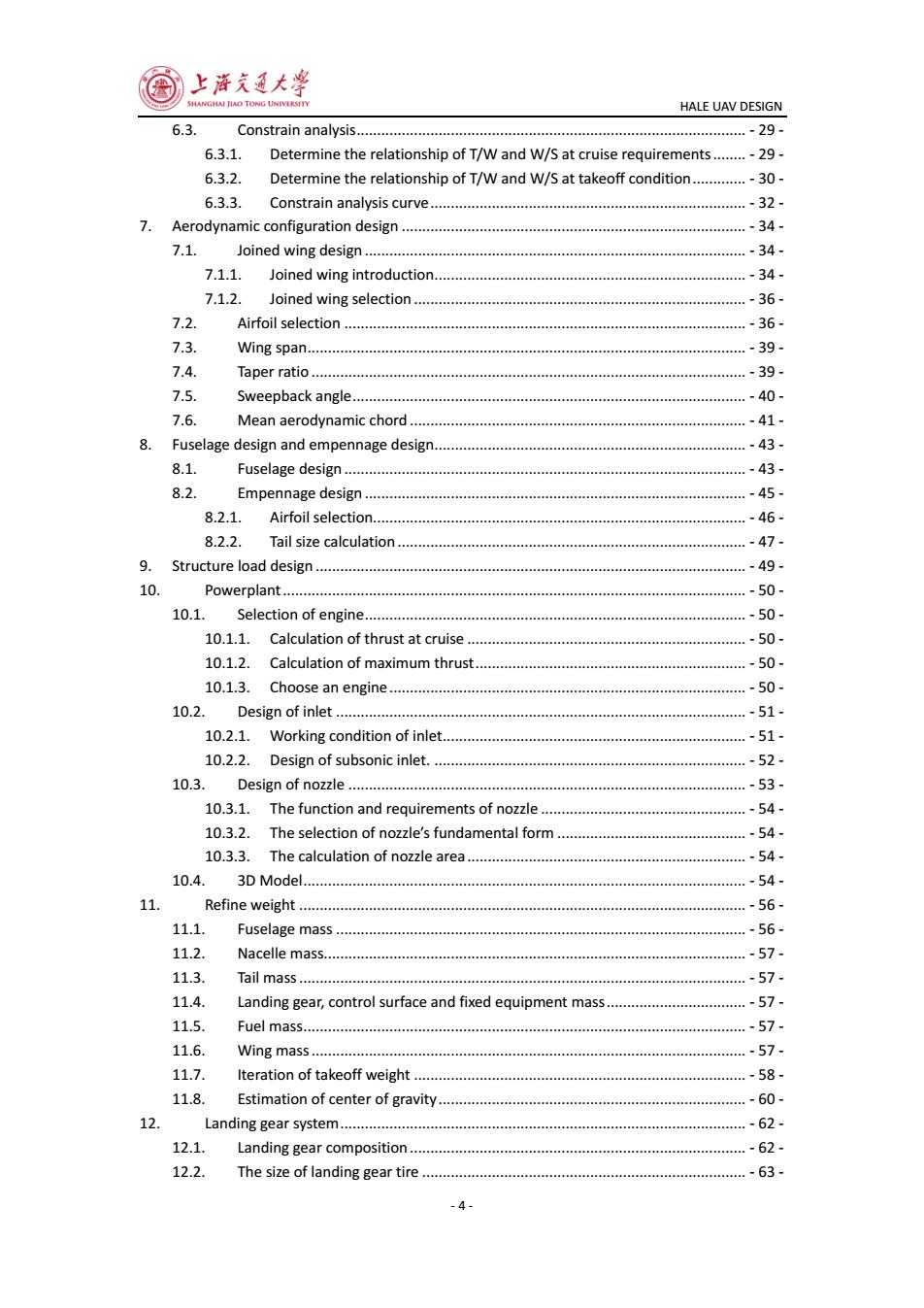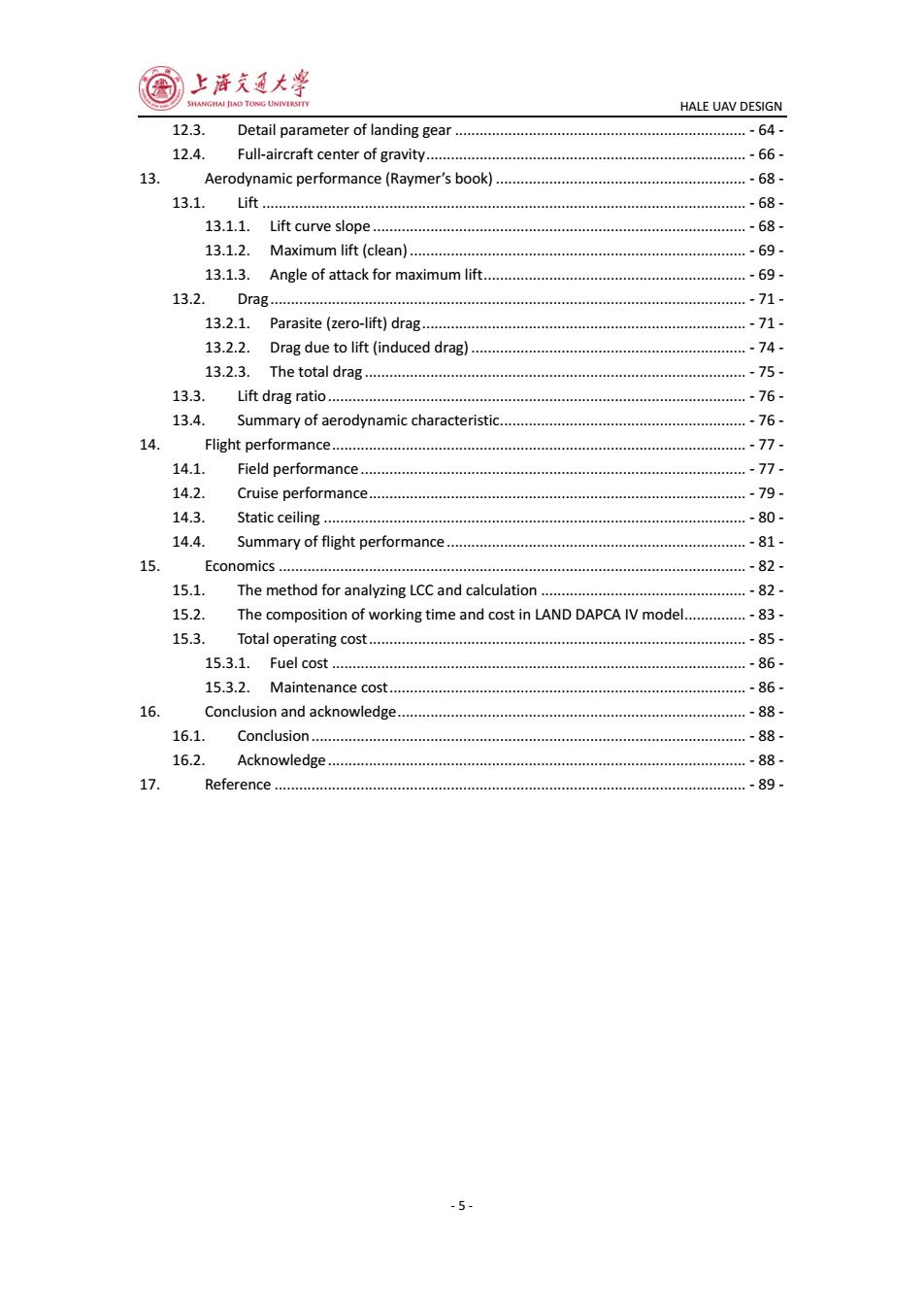
国 上游夏大学 SHANGHAI JIAO TONG UNIVERSITY HALE UAV DESIGN 上游充通大 SHANGHAI JIAO TONG UNIVERSITY SHANGHAI JIAO TONG UNIVERSTT CONCEPTUAL DES IGNOF A HIGH ALTITUDE LONG ENDURANCE UAV Team members: 胡向嘉5124139009 程晨 5124139007 赵诗鸿5124139025 邱展 5124139026 赖生智5124139028 Adviser:Prof.Song -1-
HALE UAV DESIGN - 1 - SHANGHAI JIAO TONG UNIVERSITY CONCEPTUAL DESIGNOF A HIGH ALTITUDE LONG ENDURANCE UAV Team members: 胡向嘉 5124139009 程晨 5124139007 赵诗鸿 5124139025 邱展 5124139026 赖生智 5124139028 Adviser: Prof.Song

国 上游夏大学 SHANGHAI JIAO TONG UNIVERSITY HALE UAV DESIGN CONCEPTUAL DESIGNOF A HIGH ALTITUDE LONG ENDURANCE UAV ABSTRACT This paper presents the conceptual design process of a high altitude long endura nce unmanned aerial vehicle (HALE UAV).The HALE UAV is mainly used to carry out high reconnaissance,besides it can be used in airborne early warning, communications relay,electronic jamming and head off theater ballistic missiles etc.However,China's army have no such a high altitude,long endurance UAV which can beats US RQ4A.Therefore,we brought up this program.Following t he principles of aircraft conceptual designing,the authors complete configuratio n design,weight estimation,aerodynamic design,power plant design,performa nce analysis and economy analysis step by step.All in all,we try to present to re liable,economic and efficient UAV. Keyword:HALE,UAV,conceptual design -2-
HALE UAV DESIGN - 2 - CONCEPTUAL DESIGNOF A HIGH ALTITUDE LONG ENDURANCE UAV ABSTRACT This paper presents the conceptual design process of a high altitude long endura nce unmanned aerial vehicle (HALE UAV). The HALE UAV is mainly used to carry out high reconnaissance, besides it can be used in airborne early warning, communications relay, electronic jamming and head off theater ballistic missiles , etc. However, China’s army have no such a high altitude, long endurance UAV which can beats US RQ4A. Therefore, we brought up this program. Following t he principles of aircraft conceptual designing, the authors complete configuratio n design, weight estimation, aerodynamic design, power plant design, performa nce analysis and economy analysis step by step. All in all, we try to present to re liable, economic and efficient UAV. Keyword: HALE, UAV, conceptual design

国 上海文夏大学 SHANGHAI JIAO TONG UNIVERSITY HALE UAV DESIGN CONTENT ABSTRACT. -2- 1.Introduction.… -6- 1.1. Introduction of UAV.… -6- 1.1.1. Brief history of UAV........ 6- 1.1.2.Classification of UAV............... 7- 1.2. Introduction of HALE UAV. -8- 1.3. Marketing on China's HALE... -10- 2.Design requirements............ -11- 2.1. Main goal.… …-11- 2.2. Target design parameters............ -11- 3.Payload Analysis.… .-12- 3.1. Integrated sensor system -12- 3.2. Navigation system......... -12- 3.3. Airborne communication system-13- 3.4. Assistance defense system........................... -13- 3.5. System decision......... -13- 4. Primary weight estimation. -15- 4.1. Take-off weight analysis............. .-15- 4.2. Take-off weight estimation method .-15- 4.2.1. Calculate WPL.… .-16- 4.2.2. Initial Wro. .-16- 4.2.3. Calculate Wr/Wro.… …-16- 4.2.4. Calculate Wog/Wro..... -18- 4.2.5. Iteration progress.......... -19- 4.3. 5.Primary aerodynamic performance estimation...-21- 5.1. Maximum lift coefficient estimation.-21- 5.2. Zero-lift drag coefficient estimation.............. -21- 6. Thrust-to weight ratio and wing loading................. .-25- 6.1.1. Definition of thrust-to-weight ratio.......... .-25- 6.1.2. Experience statistics. .-25- 6.1.3. Empirical formula using maximum Mach number...........................-.25- 6.1.4. T/W from climb performance........... …-26- 6.1.5. The value of T/W obtained above26 6.2. Wing loading… .-26- 6.2.1. Definition of wing loading. -26- 6.2.2. Experience statistics. -27- 6.2.3. Determined from range... .-27- 6.2.4. Determined from maximum lift coefficient and maximum speed............-27- 6.2.5. The value of wing loading obtained above...-29- -3-
HALE UAV DESIGN - 3 - CONTENT ABSTRACT..................................................................................................................................- 2 - 1. Introduction ..........................................................................................................................- 6 - 1.1. Introduction of UAV...............................................................................................- 6 - 1.1.1. Brief history of UAV.......................................................................................- 6 - 1.1.2. Classification of UAV......................................................................................- 7 - 1.2. Introduction of HALE UAV .....................................................................................- 8 - 1.3. Marketing on China’s HALE ................................................................................ - 10 - 2. Design requirements.......................................................................................................... - 11 - 2.1. Main goal............................................................................................................ - 11 - 2.2. Target design parameters................................................................................... - 11 - 3. Payload Analysis................................................................................................................. - 12 - 3.1. Integrated sensor system ................................................................................... - 12 - 3.2. Navigation system .............................................................................................. - 12 - 3.3. Airborne communication system ....................................................................... - 13 - 3.4. Assistance defense system................................................................................. - 13 - 3.5. System decision.................................................................................................. - 13 - 4. Primary weight estimation................................................................................................. - 15 - 4.1. Take-off weight analysis..................................................................................... - 15 - 4.2. Take-off weight estimation method................................................................... - 15 - 4.2.1. Calculate WPL .............................................................................................. - 16 - 4.2.2. Initial WTO ................................................................................................... - 16 - 4.2.3. Calculate WF/WTO ....................................................................................... - 16 - 4.2.4. Calculate WOE/WTO ..................................................................................... - 18 - 4.2.5. Iteration progress....................................................................................... - 19 - 4.3. Estimation result ................................................................................................ - 19 - 5. Primary aerodynamic performance estimation ................................................................. - 21 - 5.1. Maximum lift coefficient estimation.................................................................. - 21 - 5.2. Zero-lift drag coefficient estimation................................................................... - 21 - 6. Thrust-to weight ratio and wing loading............................................................................ - 25 - 6.1.1. Definition of thrust-to-weight ratio............................................................ - 25 - 6.1.2. Experience statistics................................................................................... - 25 - 6.1.3. Empirical formula using maximum Mach number..................................... - 25 - 6.1.4. T/W from climb performance..................................................................... - 26 - 6.1.5. The value of T/W obtained above .............................................................. - 26 - 6.2. Wing loading ...................................................................................................... - 26 - 6.2.1. Definition of wing loading .......................................................................... - 26 - 6.2.2. Experience statistics................................................................................... - 27 - 6.2.3. Determined from range.............................................................................. - 27 - 6.2.4. Determined from maximum lift coefficient and maximum speed............. - 27 - 6.2.5. The value of wing loading obtained above ................................................ - 29 -

上海文夏大学 SHANGHAI JIAO TONG UNIVERSITY HALE UAV DESIGN 6.3. Constrain analysis......... .-29- 6.3.1. Determine the relationship of T/W and W/S at cruise requirements........-29- 6.3.2. Determine the relationship of T/W and W/S at takeoff condition.............-30- 6.3.3. Constrain analysis curve-32- 7.Aerodynamic configuration design........-34- 7.1.Joined wing design...................... -34 7.1.1. Joined wing introduction..-34- 7.1.2. Joined wing selection....... -36- 7.2. Airfoil selection-36 7.3. Wing span...... -39- 7.4. Taper rati0… .-39 7.5. Sweepback angle.......... .-40- 7.6. Mean aerodynamic chord... .-41- 8.Fuselage design and empennage design.... .-43- 8.1. Fuselage design.... …-43- 8.2. Empennage design.............. -45- 8.2.1.Airfoil selection....... …-46- 8.2.2.Tail size calculation................ -47- 9. Structure load design................. -49- 10. Powerplant-50- 10.1. Selection of engine.… -50- 10.1.1.Calculation of thrust at cruise....... …-50- 10.1.2.Calculation of maximum thrust....... …-50- 10.1.3.Choose an engine............ .-50- 10.2.Design of inlet.... …-51- 10.2.1.Working condition of inlet............. .-51- 10.2.2.Design of subsonic inlet.-52- 10.3. Design of nozzle.… -53- 10.3.1.The function and requirements of nozzle. -54- 10.3.2.The selection of nozzle's fundamental form. …-54- 10.3.3.The calculation of nozzle area........ .-54- 10.4.3D Model …-54- 11. Refine weight .-56- 11.1. Fuselage mass-56- 11.2. Nacelle mass... -57- 11.3. Tail 11.4. Landing gear,control surface and fixed equipment mass............... .-57- 11.5. Fuel mass.-57- 11.6. Ving mass...… -57- 11.7. Iteration of takeoff weight............. -58- 11.8. Estimation of center of gravity.......... -60- 12.Landing gear system. .-62- 12.1. Landing gear composition............ .-62- 12.2. The size of landing gear tire............ .-63- -4-
HALE UAV DESIGN - 4 - 6.3. Constrain analysis............................................................................................... - 29 - 6.3.1. Determine the relationship of T/W and W/S at cruise requirements........ - 29 - 6.3.2. Determine the relationship of T/W and W/S at takeoff condition............. - 30 - 6.3.3. Constrain analysis curve............................................................................. - 32 - 7. Aerodynamic configuration design .................................................................................... - 34 - 7.1. Joined wing design ............................................................................................. - 34 - 7.1.1. Joined wing introduction............................................................................ - 34 - 7.1.2. Joined wing selection ................................................................................. - 36 - 7.2. Airfoil selection .................................................................................................. - 36 - 7.3. Wing span........................................................................................................... - 39 - 7.4. Taper ratio .......................................................................................................... - 39 - 7.5. Sweepback angle................................................................................................ - 40 - 7.6. Mean aerodynamic chord .................................................................................. - 41 - 8. Fuselage design and empennage design............................................................................ - 43 - 8.1. Fuselage design .................................................................................................. - 43 - 8.2. Empennage design ............................................................................................. - 45 - 8.2.1. Airfoil selection........................................................................................... - 46 - 8.2.2. Tail size calculation ..................................................................................... - 47 - 9. Structure load design ......................................................................................................... - 49 - 10. Powerplant................................................................................................................. - 50 - 10.1. Selection of engine............................................................................................. - 50 - 10.1.1. Calculation of thrust at cruise .................................................................... - 50 - 10.1.2. Calculation of maximum thrust.................................................................. - 50 - 10.1.3. Choose an engine....................................................................................... - 50 - 10.2. Design of inlet .................................................................................................... - 51 - 10.2.1. Working condition of inlet.......................................................................... - 51 - 10.2.2. Design of subsonic inlet. ............................................................................ - 52 - 10.3. Design of nozzle ................................................................................................. - 53 - 10.3.1. The function and requirements of nozzle .................................................. - 54 - 10.3.2. The selection of nozzle’s fundamental form .............................................. - 54 - 10.3.3. The calculation of nozzle area.................................................................... - 54 - 10.4. 3D Model............................................................................................................ - 54 - 11. Refine weight ............................................................................................................. - 56 - 11.1. Fuselage mass .................................................................................................... - 56 - 11.2. Nacelle mass....................................................................................................... - 57 - 11.3. Tail mass............................................................................................................. - 57 - 11.4. Landing gear, control surface and fixed equipment mass.................................. - 57 - 11.5. Fuel mass............................................................................................................ - 57 - 11.6. Wing mass.......................................................................................................... - 57 - 11.7. Iteration of takeoff weight ................................................................................. - 58 - 11.8. Estimation of center of gravity........................................................................... - 60 - 12. Landing gear system................................................................................................... - 62 - 12.1. Landing gear composition.................................................................................. - 62 - 12.2. The size of landing gear tire ............................................................................... - 63 -

上海文夏大学 SHANGHAI JIAO TONG UNIVERSITY HALE UAV DESIGN 12.3. Detail parameter of landing gear ...-64- 12.4. Full-aircraft center of gravity-6- 13. Aerodynamic performance (Raymer's book).......-68- 13.1. 13.1.1.Lift curve slope. -68- 13.1.2. Maximum lift(clean)… .-69- 13.1.3.Angle of attack for maximum lift.... -69- 13.2.Drag. .-71- 13.2.1.Parasite (ero-lift)drag.-71- 13.2.2.Drag due to lift (induced drag).......... -74- 13.2.3.The total drag-75- 13.3. Lift drag ratio… -76- 13.4.Summary of aerodynamic characteristic. .-76- 14. Flight performance......... .-77- 14.1.Field performance........................ …-77- 14.2. Cruise performance...-79- 14.3. Static ceiling… …-80- 14.4. Summary of flight performance-81- 15. -82- 15.1. The method for analyzing Lcc and calculation.-82- 15.2. The composition of working time and cost in LAND DAPCA IV model...............-83- 15.3. Total operating cost -85- 15.3.1.Fuel c0st........ -86- 15.3.2.Maintenance cost.... …-86- 16. Conclusion and acknowledge...... .-88- 16.1. Conclusion .-88- 16.2. Acknowledge............. .-88- 17. Reference......... .-89- -5-
HALE UAV DESIGN - 5 - 12.3. Detail parameter of landing gear ....................................................................... - 64 - 12.4. Full-aircraft center of gravity.............................................................................. - 66 - 13. Aerodynamic performance (Raymer’s book) ............................................................. - 68 - 13.1. Lift ...................................................................................................................... - 68 - 13.1.1. Lift curve slope ........................................................................................... - 68 - 13.1.2. Maximum lift (clean).................................................................................. - 69 - 13.1.3. Angle of attack for maximum lift................................................................ - 69 - 13.2. Drag .................................................................................................................... - 71 - 13.2.1. Parasite (zero-lift) drag............................................................................... - 71 - 13.2.2. Drag due to lift (induced drag) ................................................................... - 74 - 13.2.3. The total drag ............................................................................................. - 75 - 13.3. Lift drag ratio...................................................................................................... - 76 - 13.4. Summary of aerodynamic characteristic............................................................ - 76 - 14. Flight performance..................................................................................................... - 77 - 14.1. Field performance.............................................................................................. - 77 - 14.2. Cruise performance............................................................................................ - 79 - 14.3. Static ceiling ....................................................................................................... - 80 - 14.4. Summary of flight performance......................................................................... - 81 - 15. Economics .................................................................................................................. - 82 - 15.1. The method for analyzing LCC and calculation .................................................. - 82 - 15.2. The composition of working time and cost in LAND DAPCA IV model............... - 83 - 15.3. Total operating cost............................................................................................ - 85 - 15.3.1. Fuel cost ..................................................................................................... - 86 - 15.3.2. Maintenance cost....................................................................................... - 86 - 16. Conclusion and acknowledge..................................................................................... - 88 - 16.1. Conclusion.......................................................................................................... - 88 - 16.2. Acknowledge...................................................................................................... - 88 - 17. Reference ................................................................................................................... - 89 -